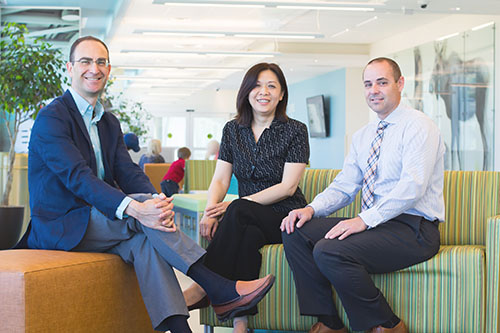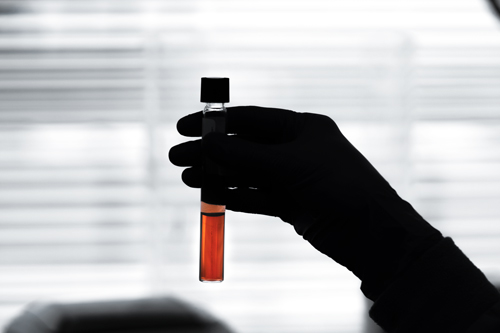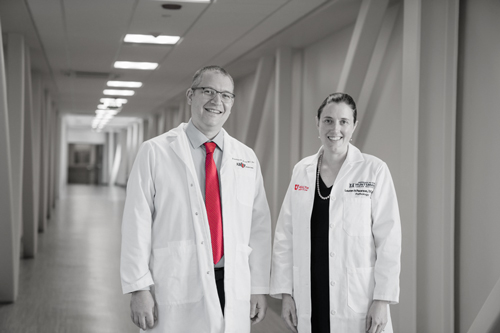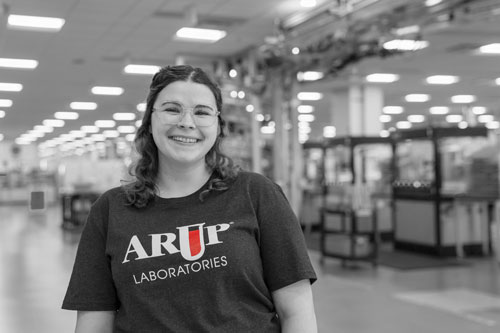Newly Arrived and Fighting for Life
A Newborn Genetic Test Searches for Answers

At 3 weeks old, the baby still had not gazed into his mother’s eyes or visually traced his father’s face. He could not open his eyes, nor could this tiny being move his arms or legs. He was trapped in a body that could not move. Each breath depended on a machine.
Doctors caring for him in the Primary Children’s Hospital’s Neonatal Intensive Care Unit (NICU) suspected a neurological issue, but without knowing specifically what was causing his catatonic state, they could not treat him.

Within five days of submitting a small sample of the baby’s blood and that of his parents, ARUP Medical Director Rong Mao, MD, saw something that might help the doctors. The baby had tested positive for a mutation located on his CHAT gene that was preventing him from producing a crucial enzyme called choline acetyltransferase that is responsible for making muscles move. The baby had congenital myasthenic syndrome. Chris Miller, one of ARUP’s 14 genetic counselors, immediately contacted the NICU with the news.
Back at the hospital, behind blinds drawn to protect babies’ eyes from the bright sunlight, a team of doctors and nurses from Intermountain Healthcare and the University of Utah gathered around the baby boy. Brandon Zielinski, MD, PhD, who was leading the Neurological Newborn Intensive Care team, injected a small vial of medicine into one of the tubes linked to the infant. It was a drug designed to compensate for his missing enzyme.
Within a few minutes, the baby boy began wriggling, and then his eyes fluttered open. Zielinski leaned in close, moving his own face from side to side to see if the baby tracked him with his eyes—the human face is a strong stimulus for babies. The boy’s eyes followed. Next, they turned off the ventilator, and the baby took his first full breath on his own. Zielinski quickly turned to a nurse. “Let’s get the parents in here.”
“It was profound; I had expected some response but not as strong as day and night,” recalls Zielinski, a University of Utah assistant professor in the Department of Pediatrics and Neurology. “It’s not often that you experience such a rush of emotion [as] this moment provided. It was impactful from both a medical and humanistic perspective.”
Time Is Life
Time is vital for these patients. The quicker the results, the sooner targeted treatment can begin. The NICU panel can provide preliminary results within five days, compared with the alternative test, exome sequencing, which takes approximately four to five weeks. At three weeks, a comprehensive final report is provided that includes all test findings. “This sequencing technology is advancing so fast, along with bioinformatics, that the time it takes to get results is going to become less and less,” says Rong Mao, MD, medical director of the Molecular Genetics and Genomics labs at ARUP.
Another factor that can eat up precious time is when doctors start ordering one individual test after another or order tests that focus on a handful of suspected genes. The process of eliminating possible diagnoses can be slow. The cost isn’t just in time but in dollars too. Tens of thousands of dollars can be racked up in testing costs along with expenses for other diagnostic tools (i.e., MRIs, spinal fluid taps) during this period.

Mao’s laboratory had been providing exome sequencing for Primary’s Children’s Hospital for undiagnosed or rare diseases, but she felt it was taking too long (35 days) and started wondering how the process could be expedited while still keeping the cost down. The rapid-panel turnaround test sequences “the highest number of genes in any panel sequenced by NGS,” says Mao, an associate professor of pathology and co-director of the Clinical Medical Genetics Fellowship Program at the University of Utah School of Medicine. “We’re looking for disease-causing mutations and then we’re looking deep to see whether it is the cause of the baby’s illness.”
The test involves collecting and analyzing blood samples from each parent and the infant, known as a trio test. Such a test costs about $2,000 for each person (total $6,000 with both parents); this is less than half the cost of comparable tests, and results can be returned in a fraction of the time.
Expertise Meets Collaboration
“What makes this test so unique is the collaboration and real-time communication with the doctors,” says Mao. The test pilot draws on expertise from ARUP, Intermountain Healthcare, and the University of Utah.
“It’s allowing us to improve on and streamline the processes of the test before opening it up to others,” says Mao. She worked with Steven Bleyl, MD, PhD, who brought together a team of specialists to come up with a system to establish specific criteria to identify which patients would most benefit from such a test. Bleyl is the director of the Intermountain Healthcare’s Clinical Genetics Institute (part of Intermountain Pediatric Genetic Testing Stewardship).
“Reaching a consensus among our clinicians on criteria for when and how we use this test helps mitigate potential risks incurred when we depend on a rapid turnaround test like this,” says Bleyl, explaining those risks might be misdiagnosing a patient based on early test results, or ordering the test and waiting for results before pursuing the standard of care that might provide answers sooner and make the test unnecessary.
The pilot will involve measuring the test’s impact on cost savings and patient care and adjusting criteria as necessary. The pilot has been underway for less than a year, but Bleyl and his team view it as a work in progress until they are satisfied with established criteria.
While the test may allow some babies to leave the NICU more quickly with targeted treatment, for others it will determine whether their conditions can even be treated. “It allows us to stop the diagnostic odyssey earlier and give families a realistic idea of what the future might hold,” says Bleyl, adding that he could foresee using this test beyond the NICU.

It was impactful from both a medical and humanistic perspective, says Dr. Brandon Zielinski, recalling the moment a baby boy opened his eyes after a genetic test helped identify what his body needed.
An Actionable Mutation: “We Can Do Something About It”
“In neonatal intensive care, a major problem is when you have a critically ill infant, and there is no clear-cut diagnosis that can be made,” says neonatologist Luca Brunelli, MD, PhD. The most common conditions in the NICU for seeking out a next-generation sequencing panel include cardio-respiratory failure, central nervous system abnormalities, an anatomic anomaly, or a syndrome affecting multiple organs. “We’ll order this panel when we want to test whether a certain diagnosis is linked to underlying genetic makeup,” adds Brunelli, explaining neurological conditions are often genetically linked.
He recalls the boy with congenital myasthenic syndrome. “It gave us an answer so we could begin treating the baby,” says Brunelli, who is an associate professor in the Division of Neonatology at the University of Utah and works in the Primary Children’s Hospital NICU. “It is what we call an ‘actionable mutation’— we can do something about it. Unfortunately, for numerous mutations we cannot do anything to fix it.”
The treatment was helpful, not curative, admits pediatric neurologist Betsy Ostrander, MD, an assistant professor of pediatrics at the University of Utah who is in the Division of Pediatric Neurology at PCH. “It allowed us to stop additional testing and that roller coaster of emotion that can be exhausting for the family when they don’t know what is going on and have to face one prospect after another with each test.”
Ostrander is excited about the transformation such a test can bring for neonatal intensive care, where use of genomics has been minimal. “There are really few things that can change outcomes of these babies, outside of antibiotics, surfactants (help protect the lungs), and echocardiography. This is a tool that can really enable us going forward.”
Why Test the Parents, Too?
“Overall, testing parents helps determine the clinical signifi cance of the variants detected in the child,” explains ARUP Medical Director Rong Mao, MD. If a genetic variant is identifi ed in a child, then scientists can look for this same variant in the parents. If neither parent has the variant, it is considered de novo; de novo variants found in the child have a higher chance of being disease causing than variants that are also found in a healthy parent.

When two mutations in the same gene are found in a child, it may cause an autosomal recessive disease such as cystic fi brosis or sickle cell anemia. Testing the child’s parents can confi rm that the mutations are located on opposite chromosomes. (Each parent carries one of the two mutations.)
If a variant is detected in the child and also in one of the healthy parents, and mutations in that gene are inherited in an autosomaldominant manner, then the variant is unlikely to be the cause of the disease. Because some dominantly inherited conditions have reduced penetrance (not everyone who inherits the mutation will show symptoms), one has to be careful before concluding the gene did not cause a child’s disorder.

















 HOME
HOME